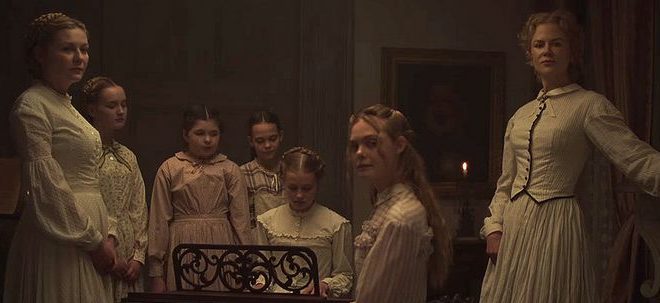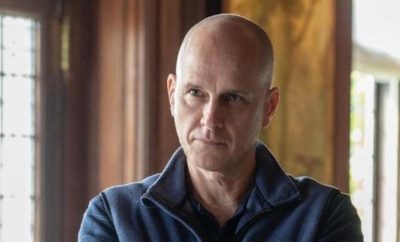
Movie Reviews
The Beguiled
By: Arlene AllenK
When I left the movie theater after seeing Sofia Coppola’s rendition of The Beguiled, I felt like the beguiled one. I had wanted to see this movie after viewing the very first trailer and I left wanting those ninety-three minutes of my life back.
Set in 1864, the third year of the Civil War, the story begins when young Amy (Oona Laurence) finds a wounded Union soldier (Colin Farrell) in the woods. Kind-hearted Amy helps him back to her lodgings, Miss Farnsworth’s Seminary for Young Ladies. Miss Martha Farnsworth (Nicole Kidman) and the other girls and ladies are horrified and appalled at the soldier’s placement on their doorstep, but Amy convinces everyone that is their Christian duty to help even a “bluebelly” – obviously a derogatory term for Yankee fighters. Miss Farnsworth assures the frightened young ladies that she will tie a blue rag around their gate so Confederate soldiers will see and take the enemy off to face whatever fate awaits a Union deserter.
But no blue rag is placed on the gate. The women and girls fall under John McBurney’s spell, even while he’s unconscious. Amy feels protective of him because she found him and she believes they have a common bond in their love of nature. Both Miss Farnsworth and Miss Edwina (Kirsten Dunst) are attracted to his beautiful male form. And rebel student Alicia (Elle Fanning), who is bored with life at the seminary, sees him as a way to make trouble.
When McBurney awakes, he dials up his charm and good old Irish brogue. He flirts with Miss Farnsworth, the uptight, orderly rule driven matron of the seminary. He preys on Miss Edwina’s insecurity as well as her dreams of escaping seminary life. He immediately senses Alicia’s desire and manipulates young, pure-hearted Amy into thinking she’s his best friend. He attempts to ingratiate himself into the hospital by helping the ladies garden and chop wood.
What follows is a tale of sexual tension, rivalries, vengeance and subtle social commentary about women’s places in society. It highlights how women were easily “beguiled” because of their situations and standing in the 19th century. For example, Miss Farnsworth lost a lover to the war and the grief behind her rigidity makes her easy prey for McBurney. Poor Edwina is an even easier mark; on the verge of spinsterhood and with no experience at all of men. How McBurney plays her and betrays her is horrific.
Unfortunately, the major problem I had with the movie is that the set-up leading to all of this takes way too long. While the cinematography is indeed impressive, I felt there were just a few too many of scenes showcasing the misty, creepy, desolate scenery. The slow build up of tension and suspense was just a little too slow.
The original film, an adaptation of Thomas Cullinan’s 1966 Southern Gothic novel, was a much subtler film. Clint Eastwood wasn’t as heavy handed with the charm and outright BS and the issue with the removal of his leg is much vaguer: did Martha and Edwina remove the leg out of necessity or out of vengeance?
In this 2017 adaptation it’s made quite clear with visuals – a gruesome shot of the horribly broken, wounded leg and by commentary as Miss Farnsworth states that removal of the leg is the only way to save McBurney’s life. This is the most pivotal sequence of the movie when the beguiler slowly becomes the beguiled and we see McBurney’s true colors.
I commend the acting in this film. Colin Farrell is great as McBurney (not to mention smoking hot; it’s no wonder all of the ladies trip over themselves for his attention). Nicole Kidman, aged up to look older than her fifty years, commands as the rigid but broken Martha Farnsworth. Kirsten Dunst, also aged up, delivers a tragic portrayal as an oft-dismissed wallflower. Elle Fanning is full of insolence as Alicia and young Oona Laurence is a scene stealer.
However, much of the suspense of the 1971 film is missing. As I stated earlier, the buildup is way too slow and the ending feels pointless. This happened, that happened and in the end…nothing happens. Yes, there is indeed a loss of innocence, but then…what happens as a result of it? How did McBurney’s presence ultimately impact their lives going forward? It’s possible that I’m over thinking the film way too much, but walking out with other movie goers I got the distinct impression they were disappointed in the film, too. (I like to talk to others after every film I review, just to get an overall perspective. All of the people I chatted up after the film wished, like me, they had gone to see something else. Older adults claimed the 1971 film was so much better).
Much of The Beguiled relies on the viewer to form their own impressions and interpretations of (sometimes) vague events. The overall reaction of the viewer relies on their own judgment. In the end, I think no review of this film is going to be a hundred percent completely reliable.
Final Analysis: Not at all what I expected, but despite my disappointment I heartily encourage movie goers to judge for themselves. At the very least the setting is impressive and both beautiful and horrifying and the acting is commendable. 5/10 C





You must be logged in to post a comment Login